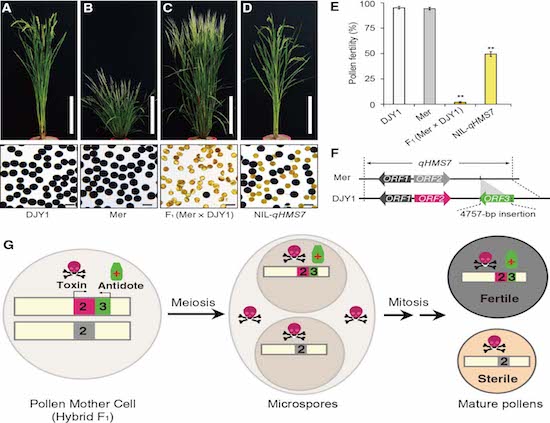Chinese Scientists Spot Selfish Genetic Element in Plants
After found in mice and nematodes, selfish genetic element is once again discovered in rice by Chinese scientists. This is the first time that selfish genetic element is found in plants, challenging the renowned Mendel’s Law of segregation. The article introducing such new findings has been published by the world’s top academic journals Science on June 8th, 2018. Dr. Yu Xiaowen and Prof. Zhao Zhigang from the College of Agriculture of Nanjing Agricultural University are the first authors of this article, and Dr. Wan Jianmin, an academician of Chinese Academy of Agricultural Sciences (CAAS), also vice president of CAAS, is the corresponding author.

What about selfish genes? The core of Mendelian genetics is the concept that gametes are equally likely to carry either of the two parental copies of a gene. In fact, offspring traits might be more similar to those of its father or mother. The same also goes to the selfish genetic element in rice. What’s more, such selfish genes weaken the advantages of O. sativa ssp japonica (DJY1) hybrids.
Theoretically, the Indica/japonica hybrids have a 15% yield advantage over the best existing indica/indica hybrids. However, Hybrid sterility, including pollen sterility, aborted embryo sac, low seed-set rate, is always together with hybrid vigor. According to the study by Dr. Wan Jianmin’s group, such phenomenon is caused by the selfish genetic elements.
Selfish genetic elements are pervasive in eukaryote genomes, but their roles remain controversial. Dr. Wan Jianmin’s group discovered the mechanism of hybrid sterility causing by the selfish genetic element. There are two closely related genes ORF2 and ORF3 in hybrid male sterility locus between O. sativa ssp. japonica (DJY1) and wild rice (Oryza meridionalis). ORF2 aborts pollen in a sporophytic manner, while ORF3 protects pollen in a gametophytic manner. Moreover, wide compatible varieties created by CRISPR technology to facilitate utilization of the strong hybrid vigor in rice agriculture.
By Yu Xiaowen
yuxiaowen@njau.edu.cn
-
 Apr 18, 2024Opening Ceremony of the Training Workshop on Wheat Head Scab Resistance Breeding and Pest Control in Africa Held in CAAS
Apr 18, 2024Opening Ceremony of the Training Workshop on Wheat Head Scab Resistance Breeding and Pest Control in Africa Held in CAAS -
 Apr 03, 2024IPPCAAS Co-organized the Training Workshop on Management and Application of Biopesticides in Nepal
Apr 03, 2024IPPCAAS Co-organized the Training Workshop on Management and Application of Biopesticides in Nepal -
 Mar 28, 2024Delegation from the School of Agriculture and Food Science of University College Dublin, Ireland Visit to IAS, CAAS
Mar 28, 2024Delegation from the School of Agriculture and Food Science of University College Dublin, Ireland Visit to IAS, CAAS -
 Mar 25, 2024Director of World Food Prize Foundation visited GSCAAS
Mar 25, 2024Director of World Food Prize Foundation visited GSCAAS -
 Mar 20, 2024Institute of Crop Sciences (ICS) and Syngenta Group Global Seeds Advance Collaborative Research in the Seed Industry
Mar 20, 2024Institute of Crop Sciences (ICS) and Syngenta Group Global Seeds Advance Collaborative Research in the Seed Industry
